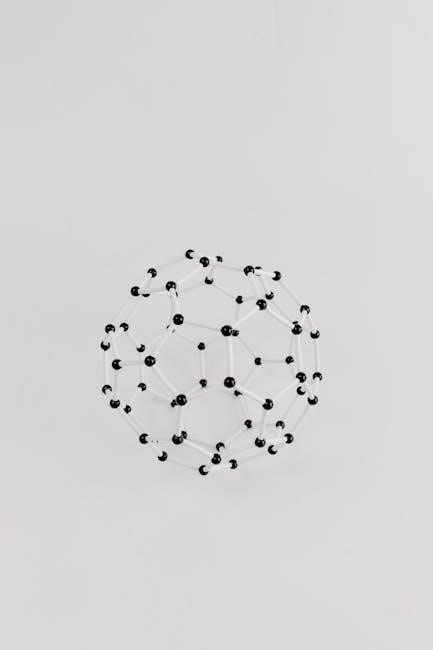Venn diagrams are visual tools using overlapping shapes to represent logical relationships and commonalities between sets. Invented by John Venn, they simplify complex data analysis, making them essential for problem-solving and education.
1.1 What Are Venn Diagrams?
Venn diagrams are visual tools used to represent sets and their relationships. They consist of overlapping circles, where each circle symbolizes a specific set or category. The overlapping areas indicate elements common to both sets, while non-overlapping sections represent unique elements. Venn diagrams are widely used in education, business, and data analysis to simplify complex relationships, making information easier to understand and compare. They are particularly useful for visualizing intersections, unions, and differences between groups, enhancing problem-solving and decision-making processes.
1.2 Historical Background and Evolution
Venn diagrams are named after John Venn, who introduced them in the late 19th century as a tool for teaching logic. Inspired by earlier versions of overlapping circles used by philosophers like Leonhard Euler, Venn refined the concept to make it more precise and visually appealing. Over time, Venn diagrams evolved from a logical representation to a versatile tool used across various fields, including education, business, and data analysis, becoming a cornerstone for understanding set theory and relationships between groups.
1.3 Why Are Venn Diagrams Useful in Problem-Solving?
Venn diagrams are highly effective in problem-solving due to their ability to visually represent relationships between different sets of information. They simplify complex data by breaking it down into overlapping categories, making it easier to identify commonalities, differences, and patterns. This clarity enables users to analyze information systematically, reducing confusion and improving decision-making. Their visual nature also enhances understanding and retention, making them an indispensable tool in both educational and professional contexts.

Understanding Venn Diagram Questions
Venn diagram questions require analyzing relationships between sets, solving logical problems, and interpreting data visually, making them essential for critical thinking and problem-solving skills development.
2.1 Types of Venn Diagram Questions
Venn diagram questions vary, including multiple-choice, true or false, and open-ended formats. They often involve identifying set relationships, calculating overlaps, or determining subset connections. Some questions focus on interpretation, while others require application of set theory principles; These questions test logical reasoning, data analysis, and problem-solving skills. They are commonly found in competitive exams and educational resources, such as Venn diagram questions and answers PDFs, which provide structured practice for mastering these concepts effectively.
2.2 Common Themes in Venn Diagram Problems
Venn diagram problems often revolve around identifying and analyzing set relationships, such as unions, intersections, and complements. Common themes include determining overlaps between categories, identifying unique elements, and calculating probabilities or proportions. These problems also frequently involve data analysis, logical reasoning, and problem-solving. Themes may vary, but they consistently test the ability to interpret and apply set theory principles effectively, making them essential for mastering logical and mathematical reasoning skills.
2.3 How to Interpret Venn Diagrams Effectively
To interpret Venn diagrams effectively, start by understanding that each circle represents a specific set or category. Identify the overlaps, which indicate shared elements between sets. Pay attention to labels and shading, as they highlight inclusions or exclusions. Analyze the distribution of elements within and outside the circles to grasp relationships. Practice visualizing data and applying set theory principles to draw accurate conclusions. This skill enhances logical reasoning and problem-solving abilities in various contexts.

Multiple-Choice Venn Diagram Questions
Multiple-choice Venn diagram questions require analyzing diagrams to select the correct answer from options. They test understanding of set relationships and logical reasoning through visual data.
3.1 Examples of Multiple-Choice Questions
Example 1: In a Venn diagram with two circles representing “Animals” and “Mammals,” which option correctly identifies the overlap? A) Birds B) Dolphins C) Trees D) Fish.
Example 2: A Venn diagram shows “Fruits” and “Vegetables.” Which option is outside both circles? A) Apple B) Carrot C) Pineapple D) Chair.
These questions test the ability to interpret overlaps and exclusives in sets, enhancing logical reasoning and problem-solving skills. They are widely used in educational assessments and professional exams to evaluate understanding of set theory concepts. Regular practice with such questions improves accuracy and speed in solving Venn diagram problems.
3.2 Strategies for Solving Multiple-Choice Venn Diagram Problems
To solve multiple-choice Venn diagram problems effectively, start by carefully analyzing the diagram and identifying the sets and their overlaps. Read the question thoroughly to understand what is being asked. Eliminate options that contradict the information shown in the diagram. Use the process of elimination to narrow down choices, and consider sketching a rough diagram if the problem is complex. Always double-check your answer to ensure it aligns with the visual representation. Practice regularly to improve speed and accuracy in identifying set relationships and overlaps.
3.3 Common Mistakes to Avoid in Multiple-Choice Questions
When tackling multiple-choice Venn diagram questions, avoid rushing through the problem without analyzing the diagram thoroughly. Misinterpreting overlaps or failing to consider all sets can lead to incorrect answers. Another common mistake is overcomplicating the problem. Stick to the information provided and avoid assuming data not shown. Additionally, ensure you read each option carefully to avoid selecting similar-sounding answers by mistake. Practice identifying these pitfalls to improve accuracy and efficiency in solving Venn diagram problems.

True or False Venn Diagram Questions
True or False questions require careful analysis of the Venn diagram to verify the accuracy of statements about set relationships and overlaps. Ensure precise interpretation of the diagram to determine the correctness of each assertion, avoiding common errors like misreading overlaps or exclusions. Practice these questions to enhance your ability to make accurate judgments based on visual data representation. This skill is essential for mastering Venn diagram problem-solving techniques effectively.
4.1 Examples of True or False Questions
True or False questions often test understanding of set relationships in Venn diagrams. For example: “Is element A only in Set B?” or “Are all elements of Set A also in Set C?” Another example: “Does the overlap between Set X and Set Y include element Z?” These questions require precise interpretation of the diagram’s structure and content. Practicing such examples helps improve accuracy in analyzing Venn diagrams. Many PDF resources offer these types of questions for effective study and skill development.
4.2 Techniques for Verifying Statements in Venn Diagrams
To verify statements in Venn diagrams, start by visually inspecting the placement of elements. Check if elements are correctly positioned within circles or overlaps. Use shading or color-coding to identify exclusions or inclusions; Cross-reference statements with the diagram’s keys or legends. Ensure all conditions in the statement align with the visual representation. Double-check for any overlaps or exclusions that might invalidate the claim. Practice with sample PDFs to master these verification techniques and improve accuracy in solving Venn diagram questions.
4.3 Best Practices for Answering True or False Questions
When answering True or False Venn diagram questions, carefully read the statement and analyze the diagram. Verify each part of the statement against the visual representation. Use elimination to identify contradictions or confirmations. Practice interpreting shaded or unshaded areas accurately. Time management is crucial; allocate a few seconds to double-check your reasoning. Familiarize yourself with common question patterns through PDF resources to enhance your problem-solving speed and accuracy. Stay calm and systematic to avoid errors during exams.

Case Study: Venn Diagram Questions in Exams
Venn diagrams are widely used in exams to analyze relationships between sets. They help visualize complex data, making problem-solving more efficient and accurate in educational assessments.
5.1 Examples of Venn Diagram Questions in Competitive Exams
In competitive exams like CAT, GRE, and GMAT, Venn diagrams are used to solve set theory and logical reasoning problems. For example, questions often involve comparing data sets, such as determining the number of students studying both Mathematics and Science. These diagrams help visualize overlaps and exclusives, making complex data easier to interpret. They are particularly useful in problems where multiple categories and their intersections are analyzed, ensuring accurate and efficient problem-solving under time constraints.
5.2 How to Prepare for Venn Diagram Questions in Exams
To excel in Venn diagram questions, start by mastering the fundamentals of set theory and understanding how overlaps represent intersections. Regularly practice with sample questions from past papers or study guides to familiarize yourself with common problem formats. Develop a step-by-step approach to interpreting diagrams quickly and efficiently. Improve time management by focusing on prioritizing questions and eliminating incorrect options. Avoid common mistakes by carefully reading each question and ensuring accurate interpretation of the diagrams. Utilize recommended textbooks or online resources to deepen your understanding and apply Venn diagrams in various contexts for comprehensive preparation.
5.3 Tips for Solving Venn Diagram Questions Under Time Pressure
When solving Venn diagram questions under time pressure, start by skimming the question to identify key information quickly. Focus on understanding the sets and their relationships. Eliminate obviously incorrect options to narrow down choices. Use the process of elimination to reduce guessing. Manage your speed by allocating time per question and avoid spending too long on a single problem. Stay calm and systematic to prevent errors. If time permits, review your answers for accuracy.

Applications of Venn Diagrams in Real Life
Venn diagrams are widely used in education, business, and data science to visualize set relationships, aiding in decision-making, market analysis, and understanding complex data interactions.
6.1 Using Venn Diagrams in Education
Venn diagrams are invaluable in education for teaching set theory, logic, and relationships between concepts. They help students visualize complex ideas, making abstract principles more tangible. Teachers use them to compare and contrast subjects, fostering critical thinking and clarity. Interactive Venn diagrams engage learners, enhancing retention and understanding in subjects like mathematics, science, and language arts. Their simplicity makes them accessible to all skill levels, promoting collaborative learning and problem-solving skills.
6.2 Venn Diagrams in Business and Management
Venn diagrams are widely used in business and management to visualize relationships between concepts like market trends, customer segments, and project workflows. They aid in strategic planning by highlighting overlaps and gaps, enabling better decision-making. Managers use them to analyze data, identify synergies, and optimize processes. Venn diagrams also facilitate communication among teams, ensuring clarity in complex projects. Their ability to simplify intricate information makes them a valuable tool for improving efficiency and collaboration in organizational settings.
6.3 Venn Diagrams in Data Analysis and Science
Venn diagrams are instrumental in data analysis and science for visualizing overlaps between datasets. They help identify correlations, patterns, and intersections, simplifying complex data relationships. Scientists use them to compare genomic data, customer preferences, or experimental results; Venn diagrams are particularly useful in bioinformatics and machine learning to illustrate set relationships. They enhance data interpretation by highlighting similarities and differences, making them a powerful tool for deriving actionable insights in scientific and analytical contexts.

Advanced Venn Diagram Questions
Advanced Venn diagram questions involve complex overlaps and multi-set comparisons, requiring precise problem-solving techniques. They are often found in competitive exams and educational resources like PDFs.
7.1 Complex Overlaps and Multi-Set Venn Diagrams
Advanced Venn diagrams often involve complex overlaps and multi-set comparisons, challenging problem-solving skills. These diagrams require careful analysis of multiple intersecting sets and precise calculations. PDF resources provide detailed exercises and solutions for such problems, helping users master multi-set Venn diagrams. By practicing these, learners can improve their ability to interpret and solve intricate overlaps, enhancing their logical reasoning and analytical skills. These exercises are ideal for competitive exams and advanced problem-solving scenarios.
7.2 Solving Advanced Venn Diagram Problems Step-by-Step
Advanced Venn diagram problems require a systematic approach. Start by identifying all sets and their relationships. Next, calculate individual and overlapping areas using given data. Use formulas to find unknown values, and verify each step to ensure accuracy. PDF resources provide step-by-step solutions to complex problems, helping users understand and apply these methods effectively. Regular practice with these exercises enhances problem-solving skills and logical reasoning.
7.3 Expert Tips for Mastering Advanced Venn Diagram Questions
Experts recommend breaking down complex Venn diagrams into simpler parts. Use color-coding to differentiate sets and overlaps. Practice interpreting multi-set diagrams regularly. Focus on understanding universal sets and subsets. Analyze common mistakes to refine your approach. Review solutions in PDF resources to grasp advanced techniques. Time management and patience are key when solving intricate problems. Consistent practice with varied question types ensures mastery of advanced Venn diagram concepts and improves problem-solving efficiency.

Venn Diagram Questions for Logical Reasoning
Venn diagrams enhance logical reasoning by visually representing set relationships. They simplify complex logic problems, making abstract concepts tangible. PDF resources provide structured exercises to sharpen this skill.
8.1 Logical Relationships in Venn Diagrams
Venn diagrams are powerful tools for illustrating logical relationships, such as unions, intersections, and differences between sets. They visually organize information, making it easier to identify overlaps and exclusivities. PDF resources often include exercises that focus on interpreting these relationships, helping users master logical reasoning. By practicing with these materials, learners can improve their ability to analyze and solve complex logical problems efficiently.
8.2 Practicing Logical Reasoning with Venn Diagrams
Practicing logical reasoning with Venn diagrams involves identifying patterns, overlaps, and exclusions between sets. PDF resources provide exercises that test the ability to translate statements into visual representations and vice versa. Regular practice helps improve problem-solving skills by enhancing the understanding of logical relationships. These exercises often include step-by-step solutions, allowing learners to track their progress and refine their strategies for tackling complex logical problems effectively.
8.3 Enhancing Logical Thinking Through Venn Diagram Exercises
Venn diagram exercises in PDF resources are designed to sharpen logical thinking by challenging learners to analyze set relationships, identify patterns, and distinguish between relevant and irrelevant information. These exercises help improve problem-solving skills, fostering the ability to break down complex scenarios into manageable parts. Regular practice enhances cognitive clarity, enabling better interpretation of data and decision-making. By mastering these exercises, individuals can develop a systematic approach to logical reasoning, making them more proficient in tackling real-world problems with precision and confidence.

Venn Diagram Questions in Mathematics
Venn diagrams are essential tools in mathematics, particularly in set theory, aiding in solving problems involving sets, unions, and intersections. PDF resources provide practice questions to enhance understanding.
9.1 Using Venn Diagrams to Solve Mathematical Problems
Venn diagrams are powerful tools for solving mathematical problems involving sets, subsets, and their relationships. They visually represent complex concepts like union, intersection, and complement, making them easier to understand. PDF resources provide numerous practice questions and answers that help students master set theory operations. By using Venn diagrams, learners can identify overlaps, exclusives, and totals, enhancing their problem-solving skills in mathematics. These diagrams are particularly useful for visual learners, simplifying abstract mathematical ideas into clear, actionable steps.
9.2 Examples of Mathematical Questions Involving Venn Diagrams
Venn diagrams are often used to solve mathematical problems involving sets, such as finding the number of elements in a union or intersection. Examples include determining how many students like both math and science or calculating probabilities in overlapping events. PDF resources provide questions like, “If Set A has 20 elements and Set B has 15, with 5 common elements, how many are in A or B?” These questions enhance understanding of set theory and logical reasoning.
9.3 The Role of Venn Diagrams in Set Theory
Venn diagrams are essential tools in set theory for visualizing relationships between sets. They illustrate unions, intersections, and complements, making complex concepts like De Morgan’s laws and Cartesian products more intuitive. By representing sets as overlapping circles, Venn diagrams simplify the understanding of subset relationships and probability calculations. They are particularly useful in teaching set theory principles and solving problems involving multiple sets and their interactions. Their visual clarity enhances logical reasoning and problem-solving in mathematics and data analysis.

Venn Diagram Questions and Answers PDF Resources
Venn diagram questions and answers PDFs are valuable study materials. They provide practice papers, solutions, and tips for mastering Venn diagram problems. These resources are widely available on educational websites and exam preparation portals, offering comprehensive guidance for students. Regular practice with these PDFs enhances problem-solving skills and improves understanding of set theory concepts. They are essential for exam preparation and logical reasoning development.
10.1 Where to Find Reliable Venn Diagram Question PDFs
Reliable Venn diagram question PDFs can be found on educational websites, exam preparation portals, and academic platforms. Websites like Khan Academy, Coursera, and ExamGuide offer high-quality resources. Many educational forums and community-driven platforms, such as Reddit and Quora, share curated PDFs. Additionally, Google Scholar and university repositories often provide access to study materials. Ensure to verify the credibility of the source before downloading to avoid outdated or incorrect content.
10.2 Recommended Venn Diagram Question and Answer PDFs
Several reputable resources offer well-structured Venn diagram question and answer PDFs. “Venn Diagrams for Beginners” and “Advanced Venn Diagram Problems” are highly recommended for their clarity and comprehensive coverage. These PDFs are available on educational platforms like ExamPrepSpot and VennPro. They include step-by-step solutions and cover various difficulty levels, making them ideal for both students and professionals. Regular practice with these resources ensures mastery of Venn diagram concepts and problem-solving techniques.
10.3 How to Use Venn Diagram PDFs for Effective Study
To maximize learning from Venn diagram PDFs, start by identifying reliable resources that offer a range of difficulty levels. Establish a consistent study routine, incorporating spaced repetition to enhance retention. Begin with simpler problems to build foundational knowledge, then progress to more complex scenarios. Engage in active learning by attempting problems independently before reviewing solutions. Practice past exam questions to familiarize yourself with exam formats and manage time effectively. Regularly review mistakes to understand and correct them, reinforcing your understanding. Consistent practice and active engagement with the material will significantly improve your proficiency in solving Venn diagram problems.
Venn diagrams are powerful tools for problem-solving, offering clear visual representations of complex relationships. Regular practice with Venn diagram PDFs enhances logical reasoning and set theory understanding effectively.
11.1 Summary of Key Points
Venn diagrams are essential tools for visualizing relationships and solving problems. They simplify complex data, enhance logical reasoning, and are widely used in education, business, and data analysis. Regular practice with Venn diagram questions improves problem-solving skills and set theory understanding. PDF resources provide comprehensive practice materials, making them invaluable for effective study and exam preparation.
11.2 Final Tips for Mastering Venn Diagram Questions
To excel in Venn diagram questions, start by understanding the basics of set theory and relationships. Practice regularly with diverse question types to build confidence. Use Venn diagram PDF resources to access structured exercises and solutions. Focus on visualizing overlaps and exclusions accurately. Break down complex problems into simpler parts. Regularly review mistakes to avoid repetition. Consistent practice and logical reasoning will enhance your mastery of Venn diagram questions over time.
11.3 The Future of Venn Diagrams in Education and Problem-Solving
Venn diagrams will continue to play a crucial role in education and problem-solving due to their simplicity and effectiveness. As digital tools evolve, interactive Venn diagrams may become more prevalent, enhancing learning experiences. Their ability to visually represent complex relationships makes them indispensable in subjects like mathematics and logic. By integrating Venn diagrams into modern teaching methods, educators can foster better understanding and critical thinking skills in students. Their relevance in problem-solving will only grow as they adapt to new educational technologies and demands;
